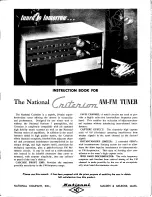
Philips Semiconductors
Product data sheet
SC28L91
3.3 V or 5.0 V Universal Asynchronous
Receiver/Transmitter (UART)
2004 Oct 21
30
OPR Output Port Register
The output pins (OP pins) drive the compliment of the data in this register as controlled by SOPR and ROPR.
Addr
Bit 7
BIT 6
BIT 5
BIT 4
BIT 3
BIT 2
BIT 1
BIT 0
N/A
OP 7
OP 6
OP 5
OP 4
OP 3
OP 2
OP 1
OP 0
N/A
0 = Pin High
0 = Pin High
0 = Pin High
0 = Pin High
0 = Pin High
0 = Pin High
0 = Pin High
0 = Pin High
1 = Pin Low
1 = Pin Low
1 = Pin Low
1 = Pin Low
1 = Pin Low
1 = Pin Low
1 = Pin Low
1 = Pin Low
ACR Auxiliary Control Register
Addr
Bit 7
BIT 6
BIT 5
BIT 4
BIT 3
BIT 2
BIT 1
BIT 0
ACR
BRG SET
Select
Counter Timer Mode
Mode and clock sour select
Delta IP3 int
enable
Delta IP3 int
enable
Delta IP3 int
enable
Delta IP3 int
enable
0x04
0 = set 1
See table 7
0 = off
0 = off
0 = off
0 = off
1 = set 2
1 = enabled
1 = enabled
1 = enabled
1 = enabled
ACR—Auxiliary Control Register
ACR[7]—Baud Rate Generator Set Select
This bit selects one of two sets of baud rates to be generated by the
BRG (see Table 5).
The selected set of rates is available for use by the receiver and
transmitter as described in CSR. Baud rate generator characteristics
are given in Table 6.
ACR[6:4]—Counter/Timer Mode And Clock Source Select
This field selects the operating mode of the counter/timer and its
clock source as shown in Table 7
ACR[3:0]—IP3, IP2, IP1, IP0 Change-of-State Interrupt Enable
This field selects which bits of the input port change register (IPCR)
cause the input change bit in the interrupt status register (ISR [7]) to
be set. If a bit is in the ‘on’ state the setting of the corresponding bit
in the IPCR will also result in the setting of ISR [7], which results in
the generation of an interrupt output if IMR [7] = 1. If a bit is in the
‘off’ state, the setting of that bit in the IPCR has no effect on ISR [7].
Table 7. ACR 6:4 field definition
ACR
6:4
MODE
CLOCK SOURCE
000
Counter
External (IP2)
001
Counter
TxC – 1X clock of transmitter
010
reserved
011
Counter
Crystal or X1/CLK clock divided by 16
100
Timer
External (IP2)
101
Timer
External (IP2) divided by 16
110
Timer
Crystal or external clock (X1/CLK)
111
Timer
Crystal or external clock (X1/CLK) divided
by 16
NOTE:
1. The timer mode generates a square wave
IPCR Input Port change Register
Addr
Bit 7
BIT 6
BIT 5
BIT 4
BIT 3
BIT 2
BIT 1
BIT 0
IPCR
Delta IP3
Delta IP3
Delta IP3
Delta IP3
IP 3
IP 2
IP 1
IP 0
0x04
0 = no change
0 = no change
0 = no change
0 = no change
0 = low
0 = low
0 = low
0 = low
1 = change
1 = change
1 = change
1 = change
1 = High
1 = High
1 = High
1 = High
IPCR[7:4]—IP3, IP2, IP1, IP0 Change-of-State
These bits are set when a change-of-state, as defined in the input
port section of this data sheet, occurs at the respective input pins.
They are cleared when the IPCR is read by the CPU. A read of the
IPCR also clears ISR [7], the input change bit in the interrupt status
register. The setting of these bits can be programmed to generate
an interrupt to the CPU.
IPCR[3:0]—IP3, IP2, IP1, IP0 Change-of-State
These bits provide the current state of the respective inputs. The
information is unlatched and reflects the state of the input pins at the
time the IPCR is read.














































